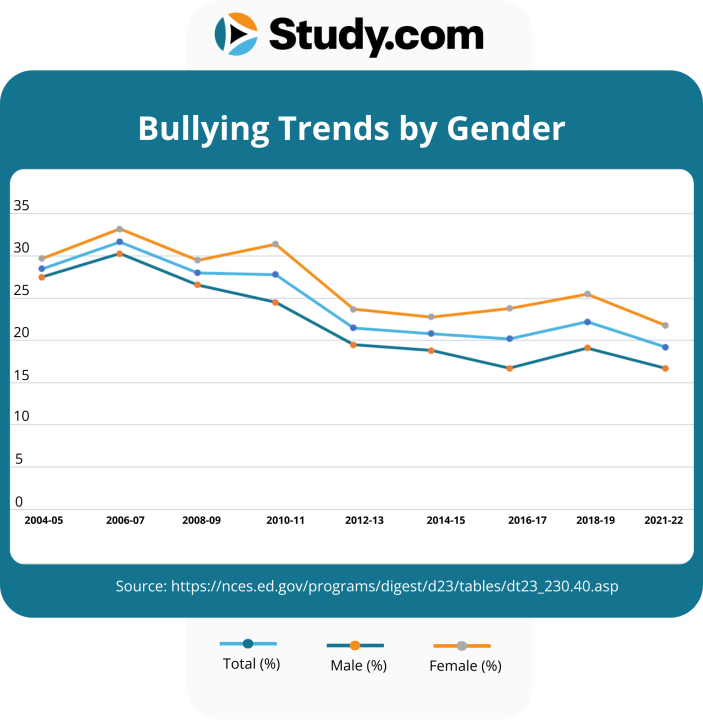Say "Boo!" to bullying: How schools can address evolving bullying trends

nimito // Shutterstock
Say “Boo!” to bullying: How schools can address evolving bullying trends
Female kindergarten teacher cheering up and calming her young pupil in classroom.
Halloween is just around the corner. But did you know that October is also Bullying Prevention Month? Now is the perfect time to examine how bullying has evolved in schools. For example, this case of a boy being bullied about his Halloween costume highlights how easily an occasion that should be festive can turn into one of bullying. While data from the National Center for Education Statistics, or NCES, reports that bullying has gone down in recent years, it still has serious negative impacts on educators, parents, and especially students, Study.com reports.
Methodology: Study.com investigated NCES data to get a clearer picture of how bullying has changed from 2004 to 2022. The data shows significant shifts by school type, grade level, and urban vs. rural settings. Understanding these patterns can help educators and policymakers better target prevention efforts and create safer environments for students. Additional data comes from NIH and Today.com.
The Evolution of Bullying Over Time
The percentage of students aged 12-18 who report bullying has seen a general decline over the past two decades. In the 2004-05 school year, for example, 28.5% of students reported being bullied. In the 2006-07 school year, this figure peaked at 31.7%. The percentage of students reporting being bullied steadily dropped, eventually falling to 19.2% by the 2021-22 school year. The largest decrease, however, occurred between 2010-11 and 2012-13, when rates fell from 27.8% to 21.5%.
The most reported types of bullying in 2022 were being the subject of rumors (13%) and being made fun of, called names, or insulted (12%).
The gradual decrease in bullying may suggest that anti-bullying campaigns and interventions have started to work. However, this trend obscures important differences across demographics, school types, and regions.
![]()

Study.com
Bullying by Gender
Graph of bullying trends by gender.
Both male and female students have reported fewer bullying incidents over the last two decades. However, female students consistently report higher rates overall. 27.5% of male students and 29.7% of female students reported being bullied during the 2004-05 school year. By the 2021-22 school year, those numbers had dropped to 16.7% for male and 21.8% for female students. The largest reported decrease in bullying occurred after the 2010-11 school year, when rates dropped from 31.4% to 23.7%.
Despite these declines, female students still face higher levels of bullying, which may reflect differences in how bullying manifests for boys and girls, with social and emotional forms of bullying more commonly reported by girls.
Where Bullying Happens
The locations where bullying occurs have remained largely consistent, with certain school areas more prone to incidents than others. Hallways and stairwells are consistently reported as the most common places where bullying takes place, followed by classrooms and outside on school grounds.
- Hallways/stairwells (43.4%): These areas are hotspots for bullying, often because they lack direct adult supervision.
- Classrooms (42.1%): Despite being supervised, classrooms remain frequent bullying locations, suggesting that bullying can be covert or that power dynamics between students persist even in more structured settings.
- School cafeteria (26.8%): School cafeterias are the third most common place for bullying.
- Cyber and text bullying (15.3%): While less common than in-person bullying, online harassment continues to be reported. However, it is growing, particularly with the rise of digital communication and social media among students.
Differences Across Regions
Bullying rates differ by school location. In 2021-2022, 23.8% of students in rural schools reported being bullied, compared to 19.0% in urban schools and 16.8% in suburban schools.
A student’s geographic location may also influence where bullying happens:
- In the Northeast, 43.4% of bullying occurred in hallways and stairwells, and 41.2% happened in classrooms, showing the greatest variability in these locations.
- In the Midwest, bullying was more consistent, with 46.2% happening in hallways and 45.3% in classrooms, indicating uniform experiences across settings.
- In the West, 25.6% of bullying occurred on school buses, standing out compared to other regions, suggesting a need for better supervision during transit.
Bullying by School Type and Setting
Bullying varies significantly between public and private schools, as well as urban, suburban, and rural settings. Public schools tend to have more consistent bullying reports across all locations, while private schools—especially Catholic and nonsectarian schools—show higher variability. This could be due to differences in student population sizes, school culture, or reporting practices.
- Private schools: Bullying in private schools is marked by higher variability in classrooms and hallways, indicating that these locations may experience more uneven enforcement of anti-bullying policies or that incidents are less frequently reported.
- Rural schools: In rural areas, bullying rates are generally higher than in cities or suburbs, with a notable 23.8% of rural students reporting being bullied in the 2021-22 school year. This could reflect differences in school size, community culture, or available resources.
Grade-Level Differences
Bullying tends to be more common in lower grades, particularly in middle school, before tapering off in high school.
- 6th graders: Bullying is highest among 6th graders, with 42.7% reporting being bullied in the 2006-07 school year. This dropped to 26.9% by 2021-22, though it remains higher than other grades.
- 12th graders: By the time students reach 12th grade, bullying rates are significantly lower. Only 14.8% of seniors reported being bullied in the 2021-22 school year. This drop may indicate significant development in the students themselves, particularly related to maturity, increased independence, or learning how to avoid situations where bullying typically occurs.
Key Takeaways and Future Prevention Efforts
While bullying rates have generally declined, there are clear hotspots—both physical locations within schools and specific demographic groups—that still require attention. Hallways, stairwells, and classrooms remain the most common sites for bullying, and female students, rural students, and those in middle school are disproportionately affected.
Moving forward, targeted bullying prevention programs should focus on improving supervision in these common bullying areas and providing specialized interventions for the most affected groups. With more consistent anti-bullying efforts, particularly in areas with the highest rates of variability, such as private and rural schools, the hope is that bullying rates can continue to decline.
Understanding where and how bullying happens is crucial to crafting effective prevention strategies. With this knowledge, schools can take the next steps to ensure that all students feel safe and supported—whether it’s Halloween or any other day of the year.
This story was produced by Study.com and reviewed and distributed by Stacker Media.